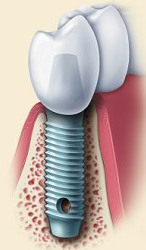Bioteeth generated from your own cells
March 12, 2013

Current design of a dental implant (credit: American Association of Oral and Maxillofacial Surgeons)
Researchers are developing a method to replace missing teeth with new bioengineered teeth generated from a person’s own gum cells.
Current implant-based methods of whole tooth replacement fail to reproduce a natural root structure and as a consequence of the friction from eating and other jaw movement, loss of jaw bone can occur around the implant.
Research towards producing bioengineered teeth (bioteeth) has largely focused on generating immature teeth (teeth primordia) that mimic those in the embryo that can be transplanted as small cell pellets into the adult jaw to develop into functional teeth, the researchers say.
Remarkably, despite the very different environments, embryonic teeth primordia can develop normally in the adult mouth. Embryonic tooth primordia cells can readily form immature teeth following dissociation into single cell populations and subsequent recombination, but such cell sources are impractical to use in a general therapy.
“What is required is the identification of adult sources of human epithelial and mesenchymal [stem] cells that can be obtained in sufficient numbers to make biotooth formation a viable alternative to dental implants,” Professor Paul Sharpe, an expert in craniofacial development and stem cell biology at King’s College London’s Dental Institute, who has led the research.
The researchers isolated adult human gum (gingival) tissue from patients at the Dental Institute at King’s College London, grew more of it in the lab, and then combined it with the cells of mice that form teeth (mesenchyme cells). By transplanting this combination of cells into mice, the researchers were able to grow hybrid human/mouse teeth containing dentine and enamel, as well as viable roots.
“Epithelial cells derived from adult human gum tissue are capable of responding to tooth inducing signals from embryonic tooth mesenchyme in an appropriate way to contribute to tooth crown and root formation and give rise to relevant differentiated cell types, following in vitro culture,” said Sharpe.
“These easily accessible epithelial cells are thus a realistic source for consideration in human biotooth formation. The next major challenge is to identify a way to culture adult human mesenchymal cells to be tooth-inducing, as at the moment we can only make embryonic mesenchymal cells do this.”
The research was funded by the National Institute for Health Research (NIHR) Biomedical Research Centre at Guy’s and St Thomas’ NHS Foundation Trust and King’s College.